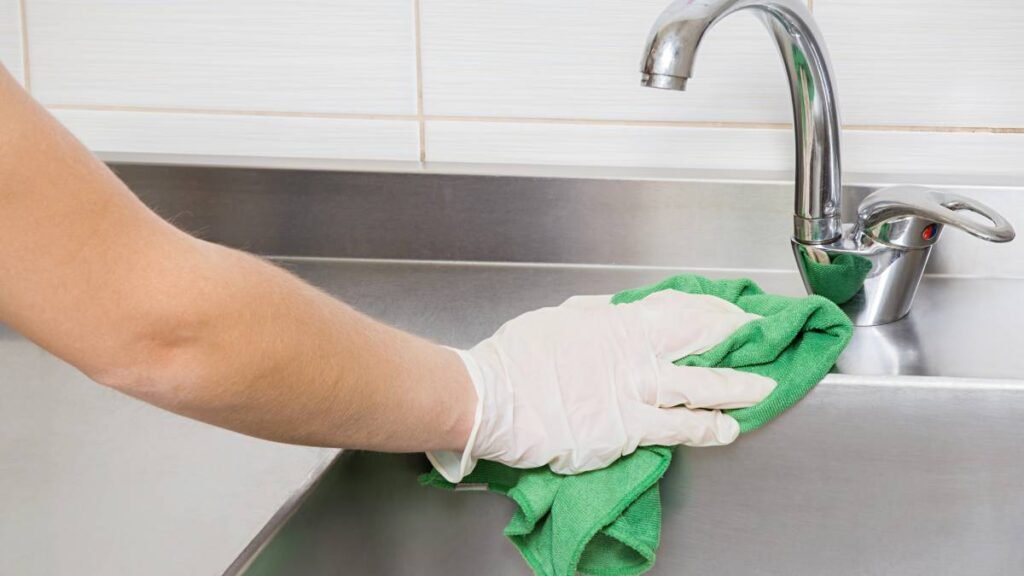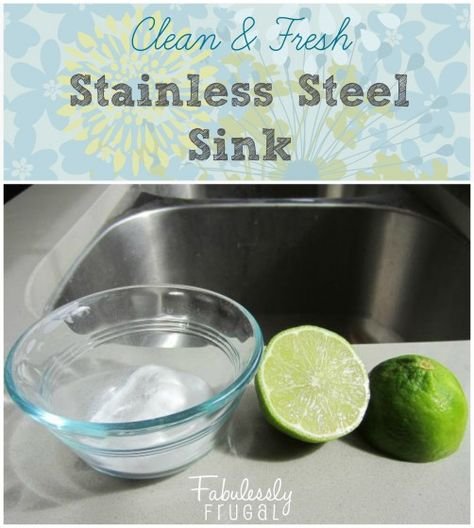Keeping your stainless steel sink in top condition is essential for maintaining both its appearance and functionality. In this ultimate guide, we’ll explore easy maintenance and cleaning tips to ensure your stainless steel sink remains spotless and free of damage. From understanding the best cleaning methods and tools to applying effective stain and rust removal techniques, we’ll cover everything you need to know. Learn how to preserve the shine and durability of your sink with straightforward tips that fit seamlessly into your routine.
Maintaining and cleaning your stainless steel sink properly can keep it looking new and functioning well for years. Here are some cleaning tips for stainless steel sinks.
Table of Contents
- Daily Cleaning Tips for stainless steel sinks
- Apply Mild Soap on the sink
- Rinse and Dry the sink
- Weekly Deep Cleaning tips for stainless steel sinks
- Stain and Rust Removal from stainless steel sinks
- Preventive Measures for stainless steel sinks
- Additional Tips to clean the stainless steel sink
- Conclusion
- How often should I clean my stainless steel sink?
- What is the best way to remove water spots from a stainless steel sink?
- Can I use bleach to clean my stainless steel sink?
- How can I prevent scratches on my stainless steel sink?
- What should I do if my stainless steel sink has rust spots?
- Is it safe to use vinegar on stainless steel sinks?
- How can I polish my stainless steel sink to restore its shine?
- How do I remove stuck-on food or residue from my stainless steel sink?
Daily Cleaning Tips for stainless steel sinks

Rinse the sink Thoroughly
After each use, rinse the sink with warm water to remove food particles and soap residue. To effectively rinse a stainless steel sink and maintain its shine, start by clearing out any debris. Use warm water and a mild dish soap, applying it with a soft sponge to clean the surface without scratching. Rinse the sink thoroughly to remove all soap residue, ensuring that water runs clear. This method helps prevent water spots and keeps your stainless steel sink looking new. Finally, dry the sink with a soft cloth to enhance its stainless steel finish and avoid streaks.
Apply Mild Soap on the sink
Use a soft cloth or sponge with mild dish soap to clean the surface. To apply mild soap on a stainless steel kitchen sink, first, choose a gentle dish soap to protect the sink’s finish. Squirt a small amount of soap onto a soft sponge or cloth. Gently rub the soapy sponge in circular motions over the entire surface of the sink, paying extra attention to areas with grease or stains. This method ensures a thorough clean without scratching the stainless steel. Rinse the sink thoroughly with warm water afterward to remove all soap residue, and then dry with a soft cloth to prevent water spots and keep your stainless steel sink looking pristine.
Rinse and Dry the sink
Rinse with clean water and dry with a soft cloth to prevent water spots. To clean a stainless steel sink, use a gentle dish soap and a soft sponge to scrub the surface, focusing on any stains or buildup. Rinse thoroughly with warm water to ensure all soap is removed. Dry the sink with a soft cloth to prevent water spots and maintain its shiny appearance.
Weekly Deep Cleaning tips for stainless steel sinks
applying the Baking Soda Paste on the kitchen sink
Sprinkle baking soda on the sink and scrub with a soft sponge. Rinse thoroughly. To clean your stainless steel sink with baking soda, start by making a paste with baking soda and water. Apply the paste to the sink using a soft cloth or sponge, gently scrubbing in the direction of the grain to remove stains and grime. Rinse thoroughly with warm water and dry with a soft cloth to prevent water spots.

Using Vinegar Spray on the sink
Spray white vinegar over the baking soda for extra cleaning power and rinse with water. To clean your stainless steel sink with vinegar, fill a spray bottle with white vinegar and spray it generously over the sink’s surface. Allow the vinegar to sit for a few minutes to break down any grease or stains. Rinse thoroughly with warm water and dry with a soft cloth for a sparkling finish.
Using olive Oil Shiner on the sink
After cleaning, apply a small amount of olive oil on a soft cloth and buff the sink to restore shine. To enhance the shine of your stainless steel sink, apply a small amount of olive oil to a soft cloth. Gently rub the olive oil onto the sink’s surface, following the grain of the steel. Wipe off any excess oil with a clean cloth for a polished, streak-free finish.
Stain and Rust Removal from stainless steel sinks
using Club Soda to remove the stains from the sink
Pour club soda over stains and scrub gently with a sponge. To remove rust from a stainless steel sink using club soda, pour a generous amount directly onto the rusted areas. Let it sit for a few minutes to allow the carbonation to lift the rust. Gently scrub with a soft cloth or sponge, then rinse thoroughly with warm water and dry with a clean cloth for a spotless finish.
Using Lemon Juice(DIY) to remove the stain from kitchen sink
For stubborn rust spots, apply lemon juice and let it sit for a few minutes before scrubbing. To remove rust from a stainless steel sink using lemon juice, apply fresh lemon juice directly to the rust spots. Let it sit for 5-10 minutes to allow the citric acid to break down the rust. Scrub gently with a soft cloth, rinse thoroughly with warm water, and dry with a clean cloth for a restored shine.

Preventive Measures for stainless steel sinks
Avoid Using Harsh Chemicals On the Sink
Do not use bleach or abrasive cleaners, which can damage the finish. Harsh chemicals can damage stainless steel by causing rust and corrosion. Strong acids or bases strip away the protective chromium layer, leading to discoloration and pitting. Abrasive cleaners can scratch the surface, making it more prone to stains and further damage. To preserve your stainless steel sink, use gentle, pH-balanced cleaners and avoid harsh chemical products.
No Steel Wool
Avoid using steel wool or harsh scrubbers that can scratch the surface. Steel wool can damage stainless steel kitchen sinks by causing deep scratches and abrasions. These scratches disrupt the smooth surface, making it easier for dirt and stains to accumulate. Additionally, steel wool can lead to rust formation as it leaves tiny metal fragments that react with moisture. To avoid damaging your stainless steel sink, use non-abrasive cleaners and soft cloths instead of steel wool.
Use a Mat
Place a sink mat or grid to protect the bottom from scratches and dents. A sink mat or grid is an effective way to protect the bottom of your stainless steel sink from scratches and dents. By placing a sink mat or grid in your sink, you create a barrier between the sink’s surface and any pots, pans, or utensils that may cause damage. This protective layer absorbs impacts and prevents scratches, keeping your sink looking new and undamaged. For best results, choose a sink mat or grid that fits snugly and is easy to clean.
Additional Tips to clean the stainless steel sink
Regular Rinsing of the sink
Rinse the sink thoroughly after handling acidic foods like tomatoes or citrus fruits to prevent discoloration. Regular rinsing helps keep your sink clean by removing loose debris and food particles before they can cause stains or odors. Simply rinse the sink with warm water after each use to wash away residues and prevent buildup. This routine helps maintain a fresher appearance and reduces the need for more intensive cleaning, keeping your sink hygienic and easier to maintain over time.
Dry the sink after Use
Always dry the sink after use to prevent water spots and mineral deposits. Using a clean, soft cloth to wipe down the sink helps remove any remaining water and prevents streaks from forming. This simple step not only keeps your sink looking shiny but also helps maintain its appearance and extends its lifespan by reducing the buildup of hard water minerals.
By following these maintenance and cleaning tips, your stainless steel sink will remain in excellent condition, enhancing the overall look and functionality of your kitchen.
Conclusion
proper maintenance and regular cleaning are key to keeping your stainless steel sink looking its best and functioning smoothly. By incorporating these easy tips into your routine—such as using gentle cleaners, rinsing frequently, and drying the sink after each use—you can prevent common issues like stains, rust, and water spots. With the right care, your stainless steel sink will maintain its shine and durability for years to come, enhancing both the appearance and hygiene of your kitchen or bathroom.
How often should I clean my stainless steel sink?
It’s best to clean your stainless steel sink daily to prevent the buildup of grime, stains, and water spots. A quick rinse and wipe down after each use can help maintain its shine and hygiene.
What is the best way to remove water spots from a stainless steel sink?
To remove water spots, use a mixture of equal parts white vinegar and water. Spray the solution onto the spots, let it sit for a few minutes, then wipe with a soft cloth. Rinse and dry the sink thoroughly.
Can I use bleach to clean my stainless steel sink?
It’s not recommended to use bleach or any harsh chemicals on stainless steel as they can damage the finish. Instead, use mild dish soap and warm water for regular cleaning.
How can I prevent scratches on my stainless steel sink?
Avoid using abrasive cleaners or scrubbing pads. Use a soft sponge or cloth for cleaning. Placing a sink mat or grid at the bottom can also help prevent scratches from pots and utensils
What should I do if my stainless steel sink has rust spots?
Rust spots can often be removed with a paste made from baking soda and water. Apply the paste to the rust spot, let it sit for a few minutes, then scrub gently with a soft brush or sponge. Rinse and dry the area.
Is it safe to use vinegar on stainless steel sinks?
Yes, vinegar is safe and effective for cleaning stainless steel sinks. It helps remove stains, disinfects, and restores shine. Just be sure to rinse the sink thoroughly afterward to prevent any potential corrosion.
How can I polish my stainless steel sink to restore its shine?
Answer: After cleaning, polish your sink using a few drops of olive oil or a stainless steel cleaner. Apply the oil or cleaner with a soft cloth, rub it in the direction of the grain, and then buff with a dry cloth to a shiny finish.
How do I remove stuck-on food or residue from my stainless steel sink?
Answer: Soak the area with warm, soapy water for a few minutes to loosen the residue. Then, use a soft sponge or cloth to scrub gently. For tougher spots, make a paste of baking soda and water, apply it to the residue, and scrub with a soft brush.
